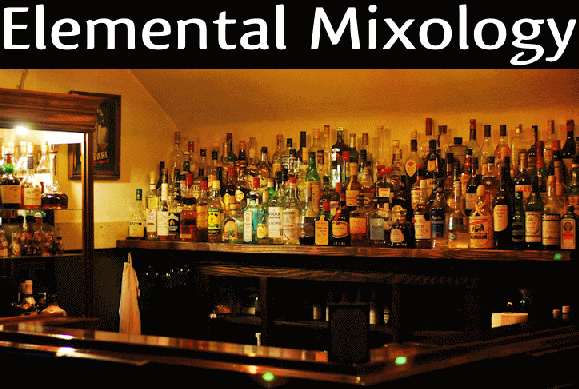THE QUEST FOR HIGH-QUALITY FLAVORED BRANDY LIQUEURS
{with formulae for Apricot-flavored Brandy Liqueur, Blackberry-flavored Brandy Liqueur, Cherry-flavored Brandy Liqueur, and Peach-flavored Brandy Liqueur}
by Andrew “the Alchemist”
We have all seen recipes that call for cherry-flavored brandy liqueur and others that simply do not exist in good quality bottlings. There are notable exceptions. Orange-flavored brandy liqueur is available in quite a few good bottlings.
I refuse to purchase or use any flavored brandy liqueur that is not made from good ingredients. For this type of liqueur, I want the flavor to come from natural ingredients that are compounded with aged brandywine - instead of imitation flavorings added to un-aged grape spirits.
I would expect that, in order for the brandy flavor to be present and married with the added flavor, the finished flavored brandy liqueur should have a minimal alcohol content of 60° {30% alcohol-by-volume}. You may notice that the orange-flavored brandy liqueurs like Gran Gala and Grand Marnier are sold at 80°, and that you can actually taste the marriage of orange peel and aged brandy. If they were sold at below 60°, you would probably begin to lose the brandy flavor.
So, with those standards in mind, it is sadly the case that there are no good-quality bottlings of apricot-flavored brandy liqueur, blackberry-flavored brandy liqueur, cherry-flavored brandy liqueur, or peach-flavored brandy liqueur – even though many drink recipes call for them.
Partially-acceptable solutions are employed by bartenders to overcome this shortcoming of the liquor industry, but they are not without drawbacks.
For example, the Blood & Sand is often made with Heering cherry liqueur in place of the originally-specified cherry-flavored brandy liqueur. Heering is a cherry ratafia liqueur. Ratafia liqueurs are compounded by macerating the flavoring material, which usually includes something aromatic, in spirits. The spirit used in a ratafia liqueur is not of as much consequence as for some other types, because the aromatic element in the maceration can overcome the flavor of the spirit, and because ratafia liqueurs are often sold at proofs too low for the flavor of the spirit used in the maceration to be an equal partner in the flavor of the finished product. Heering cherry liqueur is a ratafia of cherries (and their aromatic pits) in neutral spirits with a proprietary blend of other aromatic substances. When using Heering in place of cherry-flavored brandy liqueur in the Blood & Sand, it adds significantly to the aromatic nature of a drink that was originally sufficiently aromatized mostly by the vermouth that is also in it – to the point that an unintended bitterness can become detectable. That is to say nothing of the fact that Heering fails to contribute any of the brandy flavor that was in the original drink.
So, what does the culinarily-driven mixologist do? The answer is simple. Compound your own high-quality flavored brandy liqueurs. The simple recipes below use an affordable Cognac brandy as the base, and liqueurs from France that are made with natural ingredients. The liqueurs selected are mostly crème liqueurs, which are compounded from neutral spirits that will not complicate the flavor of the brandy. Marie Brizard Apry contains Cognac brandy, but in the new version of the product, the proof is too low for the proper brandy flavor to be present. Also, using Apry in layered drinks from the 1800’s doesn't work properly, since Apry is obviously higher in sugar and lower in proof than the apricot-flavored brandy liqueurs of the good, old days – Apry is too heavy to layer in the original order.
These are formulae that I use when teaching my fabrication course. They will produce high-quality flavored brandy liqueurs at 60° {30% alcohol-by-volume}, or slightly higher. The brandy flavor will be evident. They all use liqueurs that are sweet enough that, when mixed with the brandy, the appropriate, medium-level of sweetness for a flavored brandy liqueur will be achieved.
Apricot-flavored Brandy Liqueur
1 part Salignac V.S. Cognac Brandy {80°/40% alcohol-by-volume}
1 part Marie Brizard Apry {41°/20.5% alcohol-by-volume – older bottles are 60°}
Stir well (without ice, obviously), but not vigorously enough to appreciably aerate
Pour into a clean, dry bottle and seal with a cap or cork
Yield: good-quality Apricot-flavored Brandy Liqueur
{60.5°/30.25% alcohol-by-volume}
Blackberry-flavored Brandy Liqueur
5 parts Salignac V.S. Cognac Brandy {80°/40% alcohol-by-volume}
4 parts Edmond Briottet Crème de Mûre Liqueur {36°/18% alcohol-by-volume}
Stir well (without ice, obviously), but not vigorously enough to appreciably aerate
Pour into a clean, dry bottle and seal with a cap or cork
Yield: good-quality Blackberry-flavored Brandy Liqueur
{60.4°/30.2% alcohol-by-volume}
Cherry-flavored Brandy Liqueur
1 part Salignac V.S. Cognac Brandy {80°/40% alcohol-by-volume}
1 part G.E. Massenez Crème de Griotte Liqueur {40°/20% alcohol-by-volume}
Stir well (without ice, obviously), but not vigorously enough to appreciably aerate
Pour into a clean, dry bottle and seal with a cap or cork
Yield: good-quality Cherry-flavored Brandy Liqueur
{60°/30% alcohol-by-volume}
Peach-flavored Brandy Liqueur
5 parts Salignac V.S. Cognac Brandy {80°/40% alcohol-by-volume}
4 parts Edmond Briottet Crème de Pêche de Vigne Liqueur {36°/18% alcohol-by-volume}
Stir well (without ice, obviously), but not vigorously enough to appreciably aerate
Pour into a clean, dry bottle and seal with a cap or cork
Yield: good-quality Peach-flavored Brandy Liqueur
{60.4°/30.2% alcohol-by-volume}

